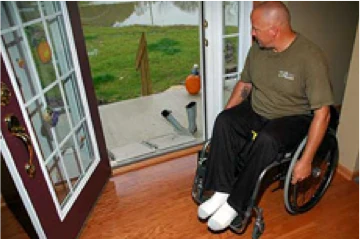Constraints for People with Disabilities

Government Code Section 65583(a)(4) requires: “an analysis of potential and actual government constraints upon the maintenance, improvement or development of housing… for persons with disabilities as identified in the analysis pursuant to paragraph (4) of subdivision (a), including land use controls, building codes and their enforcement, site improvements, fees and other exactions required of developers, and local processing and permit procedures. The analysis shall also demonstrate local efforts to remove governmental constraints that hinder the locality from meeting … the need for housing for persons with disabilities (see Screen 7).
Government Code Section 65583(c)(3) requires the housing element provide a program to ”address and where appropriate and legally possible, remove governmental constraints to the maintenance, improvement, and development of housing for persons with disabilities. The program shall remove constraints to and provide reasonable accommodations for housing designed for, intended for occupancy by, or with supportive services for, persons with disabilities.”
Housing element law requires that in addition to the needs analysis for people with disabilities, the housing element must analyze potential governmental constraints to the development, improvement, and maintenance of housing for people with disabilities; demonstrate local efforts to remove any such constraints; and provide for reasonable accommodations for persons with disabilities through programs that remove constraints.
Ordinances, policies, or practices enacted to protect the health and safety of citizens and further the general welfare must be periodically reexamined to determine whether they are accomplishing their intended purpose or, in practice, constitute a barrier to the maintenance, improvement, or development of housing with the effect of excluding housing variety and availability for the people with disabilities.
The analysis of potential and actual constraints upon the development, maintenance and improvement of housing for persons with disabilities must include, but need not be limited to:
Review Zoning and Land-Use Policies and Practices
Policies and procedures should:
- Ensure compliance with fair housing laws.
- Include a provision for group homes with more than six residents, specifically for people with disabilities, other than those residential zones covered by state law.
- Include a broadened definition of family that 1) provides zoning code occupancy standards specific to unrelated adults and 2) complies with fair housing law.
- Include siting or separation requirements for licensed, residential-care facilities to determine the extent to which the local restrictions effect the development and cost of housing
- Include any minimum distance requirements in the land-use element for the siting of special needs housing developments do not impact the development and cost of housing for persons with disabilities
- Include alternate residential parking requirements, including reduction, for people with disabilities.
Evaluate the Permit and Processing Procedures
Review the permitting and processing procedures for:
- A process to request accessibility retrofits.
- Compliance with all state laws regulating a “by-right” designation and/or permit requirements of licensed, residential-care facilities with fewer than six residents in single-family zones.
- Conditions or use-restrictions on licensed, residential-care facilities with more than 6 residents or group homes that will be providing services onsite. Evaluate the extent to which these conditions affect the development or conversion of housing for people with disabilities
- A group-home public comment period. Evaluate the extent to which it differs from other types of residential development.
Review the Building Codes
Identify:
- The year of the uniform building code adoption.
- Any amendments that might diminish the ability to accommodate people with disabilities .
- Adopted universal design elements that address limited lifting or flexibility (e.g. roll-in showers and grab bars), limited mobility (e.g. push/pull lever faucets, wide swing hinges) and limited vision (e.g. additional stairwell and task lighting).
Review for Reasonable Accommodation Procedure
Evaluate the reasonable accommodation procedure in order to:
- Identify and analyze whether the locality has an established reasonable accommodation procedure.
- Describe the process for requesting a reasonable accommodation retrofit (e.g. ramp request).
- Describe the extent to which existing requirements constrain or facilitate the application of an existing or proposed reasonable accommodation procedure (e.g. permit processing, zoning, building codes, accommodating procedures for the approval of licensed, residential-care facilities and Fair Housing Amendment Act physical accessibility efforts (e.g. American Disabilities Act retrofit efforts or other measures that provide flexibility).
Review for Programs
- Address the needs of persons with disabilities and the extent to which the local process for accommodation is different from that for other types of residential development.
- Remove or mitigate identified constraints and address the housing needs of people with disabilities.
- Ensure information is available for people who wish to request a reasonable accommodation with respect to zoning, permit processing, or building laws.
- Assist in meeting identified needs. Contact local, special-needs service providers to help identify and analyze constraints to providing housing for people with disabilities.
- Health and safety code sections 1267.8, 1566.3, 1568.08 require local governments to treat licensed group homes and residential care facilities with six or fewer residents no differently than other by-right single-family housing uses. “Six or fewer persons” does not include the operator, the operator’s family, or persons employed as staff. Local agencies must allow these licensed, residential-care facilities in any area zoned for residential use, and may not require licensed, residential-care facilities for six residents or less to obtain conditional use permits or variances that are not required of other family dwellings.
- Entitlement jurisdictions should have conducted an analysis of impediments to fair housing for the purposes of receiving funds from HUD. This impediments analysis contains similar elements and may be a useful resource for the SB 520 constraints analysis.

